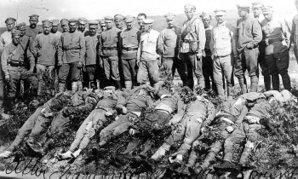5000 American Soldiers to Russia’s Frigid Climes.
But Who Is the Enemy? Who A Friend?
Special to The Great War Project.
(9 September) Americans are fighting aggressively to liberate France and Belgium, but let’s back up just a bit: At the same time, they have their sights set on another target – Siberia.
In summer 1918, the citizens of Vladivostok in the Russian far east find themselves “under yet another new administration, the Allied powers,” reports historian Gary Mead. “Copies of a proclamation were pasted up around the city informing its inhabitants that as the activities of Austro-German agents were threatening calm and peaceful business, they were now under the provisional “protection” of the Allied powers.”

POWs, probably in Siberia, 1918.
The proclamation is signed by the occupying powers – Czech, French, British, Japanese (!).
And, reports historian Mead, an Admiral Knight of the United States Navy.
“Thus began,” writes Mead, “one of the more bizarre episodes of the First World War.The opening round of Allied intervention in the internal affairs of Russia.”
“None of the Allied powers who took this high-handed act,” reports Mead, “emerged from it with any glory. Some, including the United States, thrashed about with little or no idea as to what they were even trying to achieve.”

Czech troops in Siberia, September 1918.
“The best that can be said about the doughboy contingent sent to various parts of Siberia: A witch’s cauldron of blood, politics, pillaging and intrigue as part of this Allied intervention is that it abused its power rather less than any of the other participants.”
Mead writes: “As many as 15,000 American soldiers were at different times during 1918 and beyond part of this de facto army of occupation, spread out across some 4,000 miles of north and east Russia at the height of the early days of the Russian Revolution.”
In Mead’s view, “President Wilson’s decision to join this expedition was one of the most ill-judged moves, and cast a pall over US-Russian relations for many years to come.”
“As always it was much easier to send troops in than it was to get them out.”

American troops in Siberia, September, 1918.
“This particular policing adventure left an extremely bitter taste in the mouths of many Americans back home.”
As a result of the revolution, Russia was no longer a reliable ally, especially after Lenin and the Bolsheviks took their nation out of the war. The Allies – including President Wilson — felt free to manipulate Petrograd given its now non-belligerent status.
“Most of the doughboys who went to Russia survived,” reports historian Mead,
“But many were traumatized by the climate, the living conditions, and the almost complete inability to tell who was the enemy and who a friend.”
Most significantly, the Americans were not only confronting enemy soldiers and armies. They were also facing “the most barbarous bandits of the day,” Mead reports.
But Wilson is blithely sending an initial 5,000 doughboys most of them without winter clothing, and without any real notion of what they were supposed to do in Vladivostok, Murmansk in the frigid north of Russia, and to Omsk in the heart of Siberia, among other points north and east.

Anarchy in Siberia.
These Americans were soon to find themselves, according to historian Mead, “confronting some of the most barbarous bandits of the day.

Makings of a movie. Not a told story
I’ll write it Marc. You produce it.